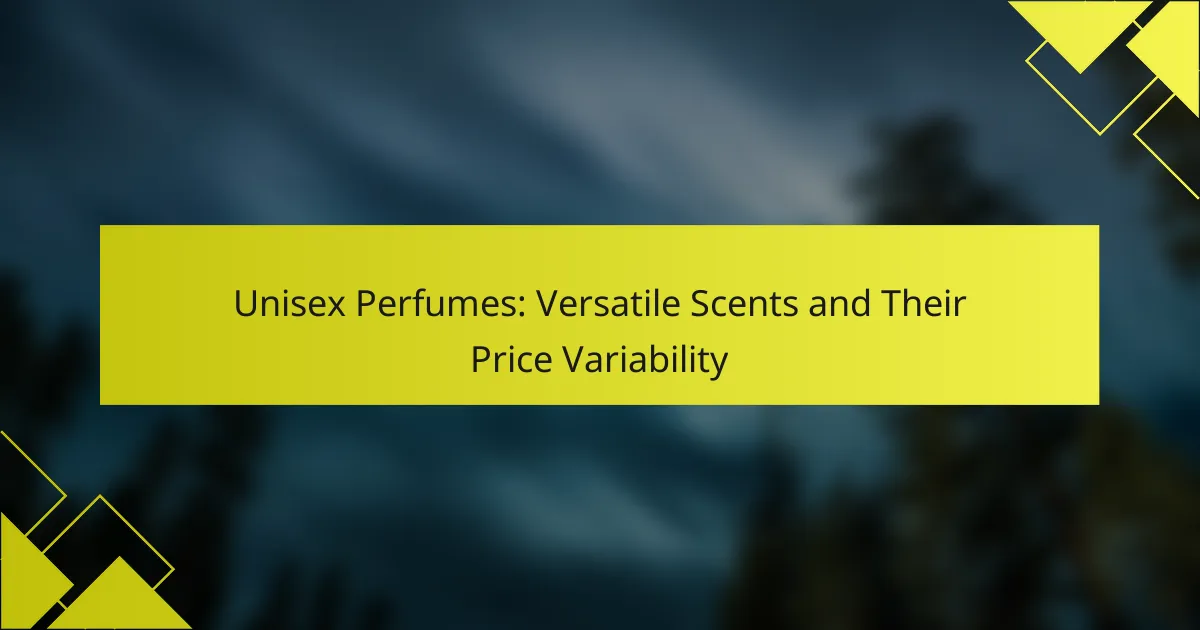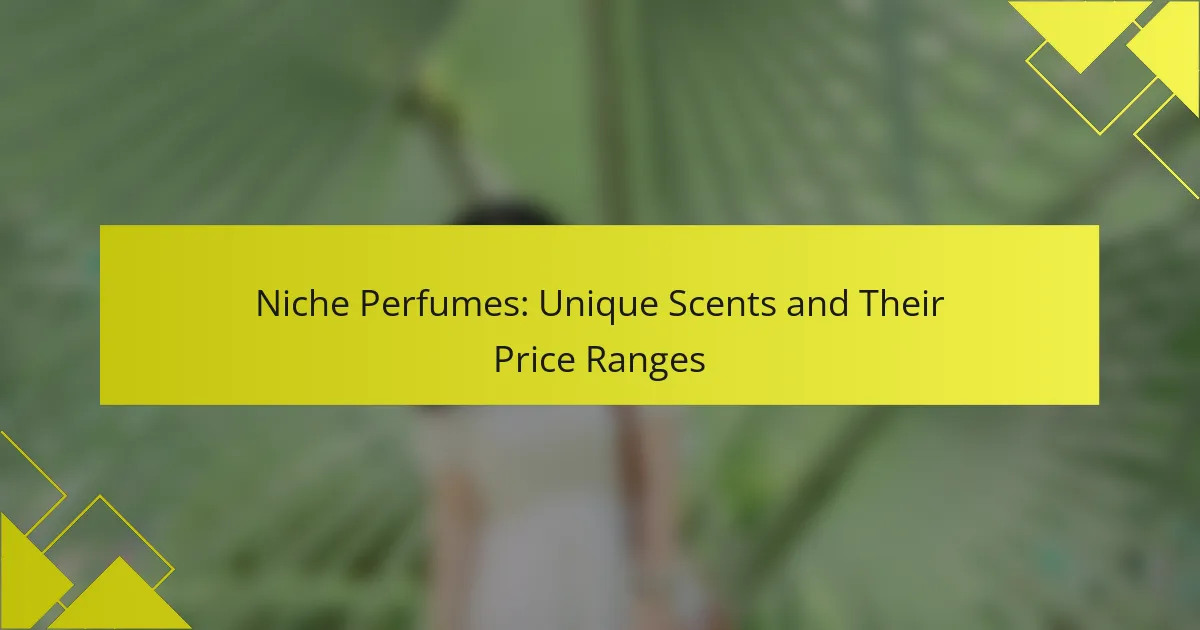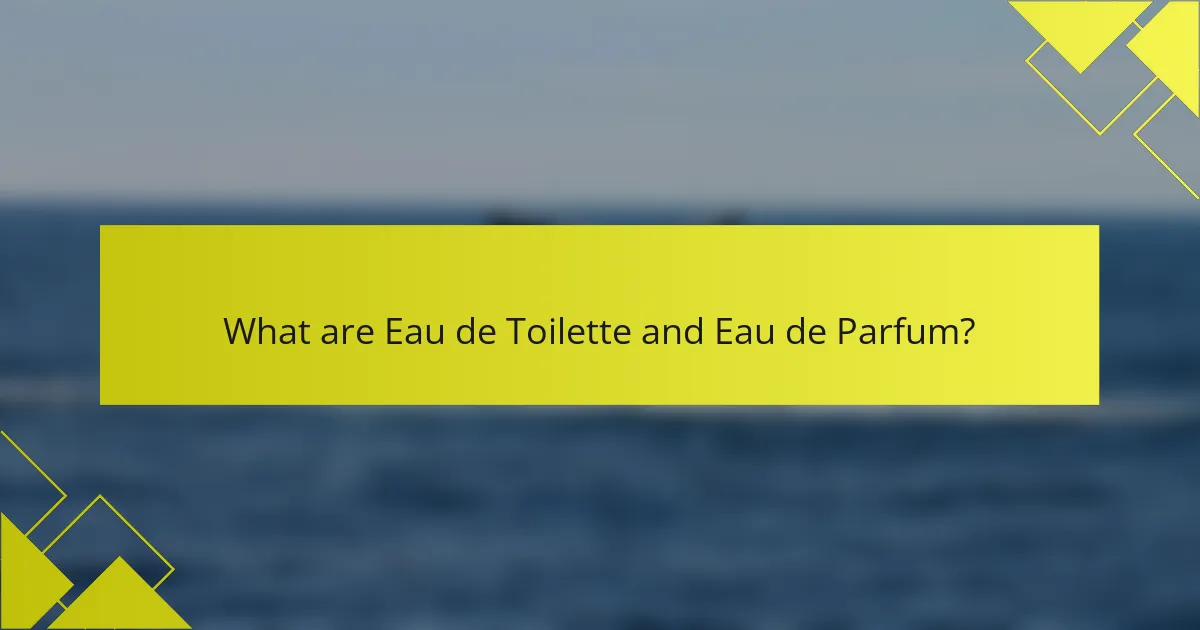
What are Eau de Toilette and Eau de Parfum?
Eau de Toilette (EDT) and Eau de Parfum (EDP) are types of fragrance classifications. EDT typically contains 5-15% concentration of fragrance oils. This results in a lighter scent that lasts about 3-5 hours. EDP, on the other hand, usually contains 15-20% concentration of fragrance oils. This higher concentration provides a more intense scent that lasts approximately 4-8 hours. The difference in concentration affects the overall fragrance experience. EDT is often preferred for casual wear, while EDP is favored for more formal occasions.
How do Eau de Toilette and Eau de Parfum differ in composition?
Eau de Toilette and Eau de Parfum differ primarily in their concentration of fragrance oils. Eau de Toilette typically contains 5% to 15% fragrance oil, while Eau de Parfum contains 15% to 20%. This higher concentration in Eau de Parfum results in a more intense scent and longer-lasting fragrance. Additionally, the base notes in Eau de Parfum are often richer and more complex due to the increased oil content. The difference in composition affects not only the fragrance’s longevity but also its overall scent profile. As a result, Eau de Parfum generally has a stronger and more pronounced aroma compared to Eau de Toilette.
What ingredients are typically found in Eau de Toilette?
Eau de Toilette typically contains a blend of essential oils, alcohol, and water. The concentration of fragrance oils in Eau de Toilette is usually around 5-15%. Common top notes include citrus, fruits, and herbs. Middle notes often feature floral and spicy elements. Base notes may include woods, amber, and musk. These ingredients work together to create a light and refreshing scent profile. The balance of these components distinguishes Eau de Toilette from other fragrance types, such as Eau de Parfum, which has a higher concentration of oils.
What ingredients are typically found in Eau de Parfum?
Eau de Parfum typically contains a blend of essential oils, alcohol, and water. Essential oils provide the fragrance, with concentrations ranging from 15% to 20%. Common notes include floral, fruity, woody, and spicy elements. Alcohol acts as a solvent, helping to disperse the fragrance. Water is included to adjust the concentration and enhance the scent’s longevity. The high concentration of fragrance oils in Eau de Parfum contributes to its richer scent profile compared to Eau de Toilette. This formulation allows for a more intense and lasting fragrance experience.
What are the typical concentrations of fragrance oils in each?
Eau de Toilette typically contains 5-15% fragrance oils. This concentration results in a lighter scent that is suitable for daily wear. Eau de Parfum usually has a higher concentration of 15-20% fragrance oils. This allows for a more intense and long-lasting scent experience. These concentrations are standard in the fragrance industry. They help differentiate the two types of fragrances based on their scent strength and longevity.
How does the concentration affect the scent experience?
Concentration significantly affects the scent experience by influencing the intensity and longevity of the fragrance. Higher concentrations, such as those found in Eau de Parfum, typically contain 15-20% fragrance oils. This leads to a more potent scent that lasts longer on the skin, often up to eight hours or more. In contrast, Eau de Toilette usually has a concentration of 5-15% fragrance oils. This results in a lighter scent that may only last around three to five hours. Additionally, higher concentrations can enhance the complexity of the fragrance, allowing more notes to be perceived. Therefore, the concentration directly impacts both the strength and duration of the scent experience.
What is the significance of fragrance oil concentration in pricing?
Fragrance oil concentration significantly influences pricing. Higher concentrations typically lead to higher prices due to the increased cost of raw materials. For example, Eau de Parfum contains 15-20% fragrance oil, while Eau de Toilette has 5-15%. This higher concentration in Eau de Parfum results in a richer scent and longer-lasting fragrance. Additionally, the production process for higher concentrations often requires more precise techniques, further increasing costs. Thus, fragrance oil concentration directly correlates with the perceived value and market pricing of the product.
What are the common uses and occasions for each type?
Eau de Toilette is commonly used for casual and daytime occasions. It has a lighter scent concentration, making it suitable for everyday wear. People often choose Eau de Toilette for work or social outings. Its refreshing nature is ideal for warmer weather.
Eau de Parfum is typically reserved for more formal or evening events. It features a higher concentration of fragrance oils, providing a longer-lasting scent. Many individuals wear Eau de Parfum for special occasions, such as weddings or parties. Its richer aroma makes it a popular choice for colder seasons.
When is Eau de Toilette typically preferred over Eau de Parfum?
Eau de Toilette is typically preferred over Eau de Parfum for casual or daytime wear. Eau de Toilette has a lighter concentration of fragrance oils, usually around 5-15%. This makes it less intense and more suitable for warmer weather. It is often chosen for its refreshing qualities. Many people prefer it for work or social settings where subtlety is key. Additionally, Eau de Toilette is generally more affordable than Eau de Parfum. This price difference makes it accessible for everyday use. Therefore, individuals often select Eau de Toilette for its practicality and versatility in various situations.
When is Eau de Parfum typically preferred over Eau de Toilette?
Eau de Parfum is typically preferred over Eau de Toilette in situations where a longer-lasting fragrance is desired. Eau de Parfum contains a higher concentration of fragrance oils, usually between 15% to 20%. This concentration allows it to last longer on the skin, often up to 8 hours or more. People may choose Eau de Parfum for evening events, special occasions, or colder weather when a more intense scent is suitable. The richer scent profile of Eau de Parfum can also be more appealing in intimate settings. Additionally, individuals who prefer a more pronounced fragrance may opt for Eau de Parfum over Eau de Toilette.
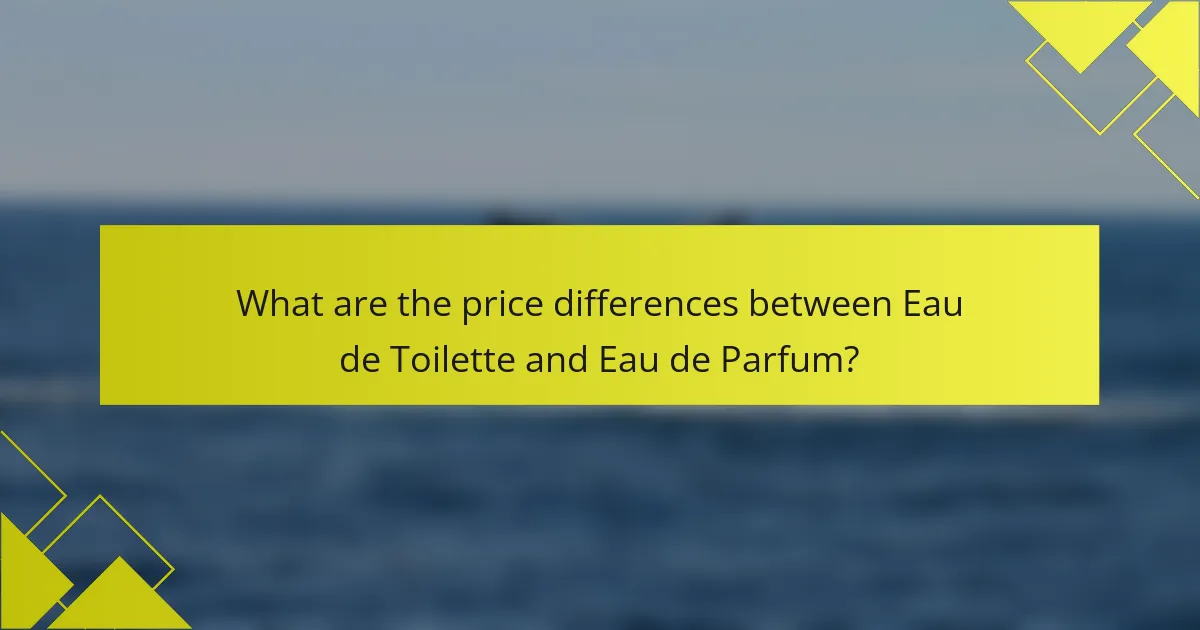
What are the price differences between Eau de Toilette and Eau de Parfum?
Eau de Toilette is generally less expensive than Eau de Parfum. Eau de Toilette typically costs between $30 to $100 for a standard bottle. In contrast, Eau de Parfum usually ranges from $50 to $150 or more. The price difference is due to the concentration of fragrance oils. Eau de Parfum contains a higher concentration, usually 15-20%, compared to 5-15% in Eau de Toilette. This higher concentration results in a longer-lasting scent, which often justifies the increased price. Additionally, brand positioning and marketing can influence pricing. Overall, consumers can expect to pay significantly more for Eau de Parfum compared to Eau de Toilette.
Why do Eau de Toilette and Eau de Parfum have different price points?
Eau de Toilette and Eau de Parfum have different price points primarily due to their concentration of fragrance oils. Eau de Parfum typically contains 15-20% fragrance oils, while Eau de Toilette contains about 5-15%. This higher concentration in Eau de Parfum results in a richer scent and longer-lasting fragrance.
Additionally, the ingredients used in Eau de Parfum are often of higher quality or more complex. This can increase production costs. The longevity and intensity of Eau de Parfum also contribute to its higher market value.
Furthermore, branding and packaging can influence pricing. Premium brands may charge more for Eau de Parfum due to perceived luxury. In contrast, Eau de Toilette is often marketed as a lighter, more casual option, which can affect consumer pricing strategies.
How does production cost influence the pricing of each type?
Production cost significantly influences the pricing of Eau de Toilette and Eau de Parfum. Eau de Parfum typically has higher production costs due to a greater concentration of fragrance oils. This concentration requires more raw materials, which increases the overall cost of production. Additionally, Eau de Parfum often involves more complex formulations and longer aging processes, further driving up costs.
In contrast, Eau de Toilette has a lower concentration of fragrance oils, resulting in reduced raw material costs. The simpler formulations and shorter production times for Eau de Toilette contribute to its lower price point.
Market pricing strategies also reflect these production cost differences. Brands often price Eau de Parfum higher to communicate luxury and exclusivity. Conversely, Eau de Toilette is marketed as a more accessible option. These pricing strategies align with consumer perceptions of value based on production costs and product characteristics.
What role does brand reputation play in pricing differences?
Brand reputation significantly influences pricing differences in products like Eau de Toilette and Eau de Parfum. A strong brand reputation often allows companies to command higher prices. Consumers perceive reputable brands as offering higher quality and reliability. This perception leads to a willingness to pay more for their products. For instance, luxury fragrance brands often price their Eau de Parfum higher than lesser-known brands. According to a study by the Journal of Marketing Research, brand equity can increase perceived value, thus justifying premium pricing. Therefore, brand reputation directly correlates with pricing strategies in the fragrance market.
What are the price ranges for Eau de Toilette and Eau de Parfum?
Eau de Toilette typically ranges from $30 to $150. Eau de Parfum usually costs between $50 and $300. The price difference is due to the concentration of fragrance oils. Eau de Toilette has a lower concentration, around 5-15%, while Eau de Parfum contains 15-20%. This higher concentration in Eau de Parfum contributes to its increased cost. Additionally, brand reputation and packaging can influence pricing for both types.
What factors contribute to the higher prices of certain Eau de Parfums?
The higher prices of certain Eau de Parfums are influenced by factors such as ingredient quality, concentration, and brand reputation. Premium Eau de Parfums often use rare and natural ingredients. These high-quality components can significantly increase production costs. Additionally, Eau de Parfums generally have a higher concentration of fragrance oils, which enhances longevity and richness. This higher concentration also contributes to the overall cost. Brand reputation plays a crucial role in pricing as well. Established luxury brands often command higher prices due to their prestige and perceived value. Packaging and marketing also add to the cost, as luxury brands invest in exquisite designs and high-profile advertising campaigns.
Are there budget-friendly options for both types of fragrances?
Yes, there are budget-friendly options for both Eau de Toilette and Eau de Parfum. Many brands offer affordable fragrances that maintain quality. For instance, popular drugstore brands provide Eau de Toilette options starting at around $15. Similarly, budget-friendly Eau de Parfum can be found for as low as $20. These options often include well-known scents that appeal to a wide audience. Retailers frequently run promotions, making it easier to find discounts on both types. Overall, consumers can explore various price points without sacrificing fragrance quality.
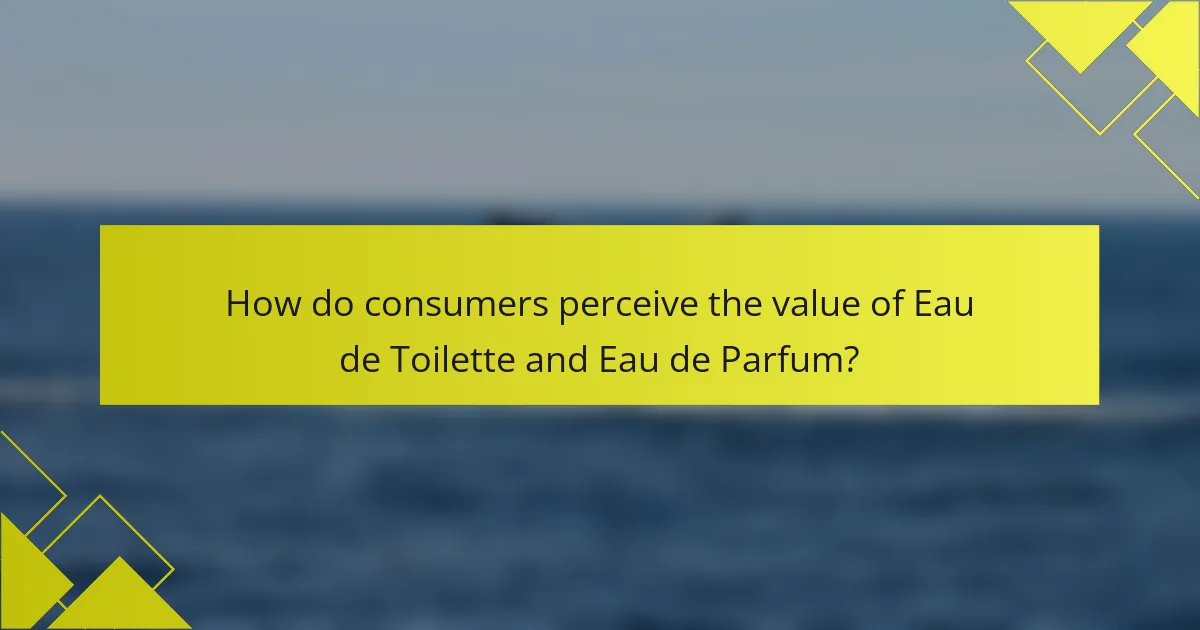
How do consumers perceive the value of Eau de Toilette and Eau de Parfum?
Consumers perceive Eau de Toilette and Eau de Parfum differently based on concentration and longevity. Eau de Parfum typically contains 15-20% fragrance oils, offering a stronger scent and longer wear time. This higher concentration leads consumers to view Eau de Parfum as more luxurious and valuable. In contrast, Eau de Toilette, with 5-15% fragrance oils, is lighter and often considered more suitable for casual or daily use.
Many consumers appreciate Eau de Toilette for its affordability and versatility. Price differences also influence consumer perception. Eau de Parfum usually costs more, reinforcing its image as a premium product. Research shows that consumers often associate higher prices with better quality in fragrances.
This perception aligns with market trends, where sales of Eau de Parfum have increased, indicating a preference for longer-lasting scents. Overall, consumers value Eau de Parfum for its intensity and longevity, while they appreciate Eau de Toilette for its accessibility and everyday usability.
What factors influence consumer choices between Eau de Toilette and Eau de Parfum?
Consumer choices between Eau de Toilette and Eau de Parfum are influenced by factors such as fragrance concentration, longevity, and price. Eau de Parfum typically has a higher concentration of fragrance oils, around 15-20%, compared to Eau de Toilette, which contains about 5-15%. This higher concentration in Eau de Parfum results in a longer-lasting scent, often lasting up to 8 hours or more. In contrast, Eau de Toilette may last around 3-5 hours.
Price also plays a significant role in consumer decisions. Eau de Parfum is generally more expensive due to its concentrated formulation and longer-lasting qualities. Consumers often weigh their budget against the desired fragrance experience. Additionally, personal preferences for scent strength and occasion can influence choices. Some consumers prefer the lighter, fresher scent of Eau de Toilette for daytime use, while others opt for the richer aroma of Eau de Parfum for evening or special events.
Ultimately, these factors—fragrance concentration, longevity, price, and personal preference—combine to shape consumer choices between the two types of fragrance.
How do longevity and sillage impact consumer preferences?
Longevity and sillage significantly influence consumer preferences in fragrance selection. Longevity refers to how long a fragrance lasts on the skin. Consumers often prefer perfumes with longer-lasting scents, as they reduce the need for reapplication. Sillage describes the trail of scent left behind by the fragrance. A strong sillage can enhance a wearer’s presence and attract compliments, making it a desirable attribute. Research indicates that consumers are willing to pay more for fragrances with higher longevity and sillage. For instance, a study published in the Journal of Consumer Research found that consumers perceive lasting fragrances as more luxurious. This perception drives preferences toward Eau de Parfum over Eau de Toilette, as the former typically offers better longevity and sillage.
What role does personal preference play in perceived value?
Personal preference significantly influences perceived value in fragrance products. Individuals often associate specific scents with personal experiences or emotions. This association can elevate the perceived worth of a fragrance. For instance, someone may prefer Eau de Parfum for its longevity and richness. This preference can lead them to perceive it as more valuable than Eau de Toilette. Studies show that emotional connections to scents can enhance their perceived value. Therefore, personal preference shapes how consumers evaluate and prioritize fragrances.
What are the common misconceptions about Eau de Toilette and Eau de Parfum?
Eau de Toilette and Eau de Parfum are often misunderstood regarding their concentration and longevity. A common misconception is that Eau de Toilette is of lower quality than Eau de Parfum. However, both types serve different purposes and preferences. Eau de Toilette typically contains 5-15% fragrance oil, while Eau de Parfum contains 15-20%. This difference in concentration affects their scent strength and longevity. Eau de Parfum generally lasts longer, but Eau de Toilette can be more suitable for casual or daytime wear. Another misconception is that Eau de Parfum is always more expensive. Prices can vary widely based on the brand and formulation, not just the type. Understanding these distinctions helps consumers make informed choices when selecting fragrances.
Why might consumers underestimate the value of Eau de Toilette?
Consumers might underestimate the value of Eau de Toilette due to its lower concentration of fragrance oils compared to Eau de Parfum. Eau de Toilette typically contains 5-15% fragrance oils, while Eau de Parfum contains 15-20%. This lower concentration can lead consumers to perceive Eau de Toilette as less luxurious or less long-lasting. Additionally, marketing often emphasizes the higher-priced Eau de Parfum, reinforcing the idea that more expensive means better quality. Many consumers are also unaware that Eau de Toilette can be more suitable for daily wear, offering a lighter scent that is less overpowering. Furthermore, the price point of Eau de Toilette is often lower, which can lead to misconceptions about its overall quality and efficacy. This results in consumers overlooking the versatility and appeal of Eau de Toilette in favor of its more expensive counterpart.
How can understanding the differences enhance consumer satisfaction?
Understanding the differences between Eau de Toilette and Eau de Parfum enhances consumer satisfaction by enabling informed purchasing decisions. Consumers can choose products that align with their preferences for scent intensity and longevity. Eau de Parfum typically has a higher concentration of fragrance oils, resulting in a longer-lasting scent compared to Eau de Toilette. This knowledge helps consumers select a product that meets their expectations for duration and projection. Additionally, understanding price differences allows consumers to assess value based on their budget and usage needs. Research indicates that informed consumers are more likely to express satisfaction with their purchases, as they feel empowered by their choices.
What tips can help consumers choose between Eau de Toilette and Eau de Parfum?
Eau de Toilette has a lighter concentration of fragrance oils compared to Eau de Parfum. Consumers should consider the longevity of the scent. Eau de Parfum typically lasts longer, often up to eight hours, while Eau de Toilette may last four to six hours.
Fragrance intensity is another factor. Eau de Parfum offers a stronger scent profile, making it suitable for evening wear. In contrast, Eau de Toilette is often preferred for daytime or casual use.
Price is also a key consideration. Eau de Parfum usually costs more due to its higher concentration of fragrance oils. Consumers should assess their budget and usage frequency.
Testing the fragrances on the skin is advisable. Skin chemistry can alter the scent, making it essential to try before purchasing. Lastly, consider the occasion. For formal events, Eau de Parfum may be more appropriate, while Eau de Toilette suits everyday scenarios.
Eau de Toilette (EDT) and Eau de Parfum (EDP) are two classifications of fragrances distinguished primarily by their concentration of fragrance oils, which affects their scent intensity and longevity. EDT typically contains 5-15% fragrance oils and lasts about 3-5 hours, making it suitable for casual wear, while EDP contains 15-20% fragrance oils, lasting approximately 4-8 hours, ideal for formal occasions. The article explores the differences in composition, common uses, price ranges, and consumer perceptions of both fragrance types, highlighting how these factors influence purchasing decisions and perceived value. Understanding these distinctions can enhance consumer satisfaction by guiding informed choices based on individual preferences and needs.
